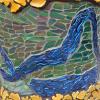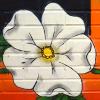'Bernd Oppl: Inhabited Interiors' Presents Experimental Films
Art Notes

Sick Building
"Bernd Oppl: Inhabited Interiors," currently on view at the Georgia Museum of Art, consists of Sick Building, Hotel Room and Flock, three short, silent and black-and-white films by Austrian video and installation artist Bernd Oppl. Strongly inspired by horror film aesthetics, particularly Alfred Hitchcock's use of architectural elements to create dramatic narratives—windows representing voyeurism, doors transitioning into new scenes, stairs creating tension—Oppl constructs painstakingly accurate miniature models to use as settings for his films. Each model is visualized as a compilation of backdrops from mainstream cinema, then sketched out digitally, fleshed out with physical materials and finished off with motorization and mechanics. Lacking a human presence, each space serves as the protagonist when unpredictable substances are introduced to interact with, or inhabit, the mysterious interiors. When each substance appears to defy the laws of physics, the viewer's perception and sense of reality are challenged.
Sick Building opens into the corner of a sterile, white-walled hallway lined with closed black doors. From behind a corner, a stream of white, gelatinous goo emerges, slowly rolling across the floor to form a puddle. The substance begins developing tentacle-like stalactites that reach upward and abruptly break off against gravity, attaching to the ceiling as if pulled by a magnet. From there, the substance gradually drips back down, coalescing like mercury, only to splatter itself against another wall. As the goo's movements accelerate, erratically and chaotically taking over, it takes on an eerily organic quality, as if becoming increasingly more agitated within the confines of its space.
Hotel Room takes place within a stark hotel room reduced to pure functionality. While the universal bedroom set consisting of a double bed with crisp white sheets, basic nightstand with a reading lamp and small desk with a chair are all present, the room lacks any aesthetic or personalized details that hotel rooms often incorporate to create a warm, surrogate living space. This minimalism reinforces the role of hotel rooms as simple stopovers between travel destinations—the inconsequential, present setting between a past and future location—as well as the ability of hotel rooms to exist as oases removed from everyday life. Oppl's short film attempts to suspend reality by literally freezing this fleeting, transitional space.
As the film begins, liquid slowly rises from the floor. The fluid's slow creeping up the corner of the room and extending over the legs of the chair before its surface level catches up is subtly alarming. The camera adjusts its focus over to the bed, where a gelatinous film begins spreading over the telephone and doorknob, creating elements of claustrophobia and confinement. The milky, translucent film thickens and crystalizes, becoming a growing layer of ice. The reflection of light on the surface of the slushy cocoon as it solidifies creates a gentle movement, making it appear to pulsate or breathe.
Flock best represents Oppl's intricate methods of working within a miniature set to play with the perceptions of architecture, movement and dimension. The smudged walls of an apartment building appear without the presence of any furniture, holding only doors, a corridor and a stairway leading to the unknown. A black cloud of scarab- or locust-like beings—created by a handful of tiny poppy seeds—swarms through each room, highlighting the angles of the space as they accumulate in crevices and corners. As quickly as they flood in, they are blown away. The camera appears to mimic the flock's constant, swirling frenzy as it circles around for an escape, a perception created by rotating the model and camera together by means of a motor.
"Bernd Oppl: Inhabited Interiors" will be on view through Tuesday, Sept. 16 in the Alonzo and Vallye Dudley Gallery, which focuses on new media art.
Keywords
More by Jessica Smith
-

Art Around Town
A list of local art exhibits.
-

-

Art Around Town
A list of local art exhibits.









comments